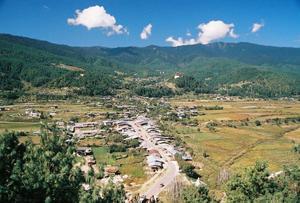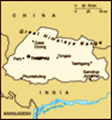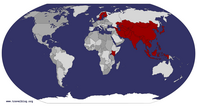Advertisement
Published: January 3rd 2007

 Looking down on Jakar
Looking down on Jakar
Yep, another lovely morning in Bhutan.We're waking up to another glorious day, the sun shines brightly in a cloudfree blue sky, and the temperature is chilly enough to make the cold morning shower feel like a chore. For the first time of the trip we are allowed the luxury of staying in the same place two nights in a row, Tshering having scheduled visits to the remaining temples and sights here in Bumthang. Mr Dorji, proprietor of the Gongkhar guesthouse, offers up a toast and cornflakes breakfast, cycling the menu a bit to keep things interesting. This man really deserves recognition for his spotless operation, and I would heartily recommend a stay at his guesthouse if you happen to be in town.
After breakfast Tshering suggests we go back to
Lhodrak Kharchhu Shedra, the buddhist college located on a hill above town, to take some pictures of Jakar now that the light is good. While getting ready to drive back to town we discover that a stray dog has placed itself in the shadow under the car and refuses to leave. Finally Dorji has to slowly back the car away without the dog as much as blink. We quickly see that all is not well

 Early bird...
Early bird...
The crows and ravens in Bhutan are careful but generally not as shy as back in Europe.with this dog, his fur being bared and the rosy flesh exposed and attacked by maggots. Tshering is very upset, since the monks are supposed to be taking care of animals in poor condition like this one.
On the way down we drive past a vehicle repair shop that caught my attention yesterday, or rather, the two lorry hulks standing in the courtyard beg to be photographed. Again Tshering laments, and explains to me how sad it is to see two such fine trucks being left to rot. These are not the typical Indian Tata lorries, but very modern and high performing Nissan Diesels donated by Japan, although these two examples will never again serve proudly. Apart from India, Japan is a very important contributor to the Bhutanese economy, being one of the largest donators. It is not uncommon to see Japanese trucks and machinery at work in the road widening program.
Just next to the repair yard is a small cheese factory that we intended to visit yesterday, but it was already closed. The project is supported by none other than Switzerland itself. During our brief visit we meet an employee who is finishing off the day's
produce, watched carefully by a Japanese journalist who has set up his camera on a tripod. The Japanese guy introduces himself and explains he works for a magazine specializing in food and is doing some sort of article on the Bhutanese cheese. He shakes my hand enthusiastically and starts asking me questions, turns out he thought I was the Swiss manager! After the mix up and some embarrassing laughs we head back downtown to try our luck with the bank again. This time it is actually open and it is full of people squeezing themselves against the teller's desks trying to get help all at once. Due to the formalities for foreigners to exchange money we simplify the transaction by letting Tshering do the exchange.
Done at the bank we can finally begin with the proper sightseeing of the day. The first target is
Lake Membar Tsho, a.k.a. the burning lake. Having seen one of the biggest lakes already I know what to expect - a small pool of sorts. Located a short trip outside of town we walk down a small trail until we reach the stream of the Tang Chhu river. There are som big boulders and

 End of the line
End of the line
The remains of a Nissan Diesel truck from the Bumthang Central Machinery Unit.rocks here overlooking a widened pool of the stream itself, the whole area dressed in prayer flags and some butter lamps. Another interesting finding is a lot of small cupcake looking ceramic statuettes that have been placed in large numbers in crevasses between the rocks. Tshering explains their purpose, being miniature stupas placed here to bless and honour the deceased. As with prayer wheels in general, the more the merrier, so it is not uncommon for people to make and place a large group of these miniatures. Down in the water we can see a few burning candles floating on tiny wooden rafts, having also been placed there by the faithful. Membar Tsho itself is considered a holy place since the famous
Guru Rimpoche hid important buddist treasures here. They were discovered several centuries later by
Pema Lingpa, one of the most famous treasure seekers in Bhutanese history. It is said he dove into the lake and emerged with the sacred scriptures in hand.
After our visit it is already time for lunch so we head back to the guesthouse. I notice that my stomach is starting to feel a bit unruly, and my throat is feeling coarse, not

 Nissan Diesel L6 Turbo 290
Nissan Diesel L6 Turbo 290
Another Bumthang CMU workhorse left to rot in the sun.a good sign. But, there will be no rest for the wicked. After a lunch consisting of beef with radishes, red rice, carrots, peas, potato cheese and marinated mushrooms we head out again to cover the main temples of the western side of the Choskhor valley, having done the eastern side already yesterday. First in line is the charming
Jampa Lhakang, a temple devoted to Jampa, or as he is also know,
Maitreya; the future Buddha. Similar to the story of the second coming, Maitreya will be reborn here on Earth sometime in the distant future, some sources say 4000 years after the passing of
Buddha Sakyamuni, the famous teacher from the 5th century also known as Siddharta Gautama. It is also said that at this time, mankind will have continued to deteriorate, her greed, selfishness and struggles for power slowly consuming the world. Maitreya will be recognized by the purity of his appearance and speech. For now though, we are definitely living in between these two masters.
Our visit to Jampa Lhakang is a very peaceful experience, a few faithful revelers are here for their daily practice. A group of old citizens that come here often, carefully making
their rounds around the main temple building as well as the big chortens flanking it. Many have brought a pile of small stones with them, for each completed circle they add a rock to a small pile at the side of the chorten to keep track of their progress. This very tantric form of buddhism focuses on gaining merit by performing mundane and repetitive actions such as spinning the prayer wheels or walking round the sacred objects. Dorji of course finds some barrel-sized prayer wheels giving them a good spin...
Not thinking this can be bettered we continue our trip on a dirt road going north towards the next temple complex, which is no less amazing. The
Kurjey Lhakang complex consists of three magnificent temples standing next to each other almost giving the impression of a majestic dzong. The oldest and smallest building that also gives the complex its name was centered around a sacred bodyprint left by the meditating Guru Rinpoche. Inside the main chamber you can see a large altar surrounded by the thousand buddhas, represented by line after line of small statues on shelves along the walls. The second temple holds more of the little buddha
figures and also features a large statue of the seated Guru Rinpoche. As I stare down on the ten meter tall statue from a window on the upper floor our eyes meet in a strange and chilling way. The third temple, finally, is a recent construction by one of the queen mothers and functions as her private temple, and it is normally closed for visitors. However, we are lucky since two other tourists have been let inside and we quickly tag along to catch a glimpse of the large chamber, surrounded by big statues of the eight manifestations of the great Guru.
At the entrance to the first temple is a small entrance in the wall. Tshering explains you are supposed to crawl inside and emerge from a similar hole further down the wall. By crawling through this narrow passage your sins will be scraped off. After encouraging Dorji to give it a try he quickly finds the hatch to seal the exit of the passage so that poor Dorji will be left fumbling in the dark... We also meet with some of the young monks at work refreshing the floorbords by painting them a bright red. We've come
just in time for the annual tsechu festivities, scheduled to start tomorrow. Unfortunately we do not have time to remain here to watch the tsechu, as tomorrow we will undertake the long journey to Mongar town in the east of the country.
Our last stop for the day is the
Thangbi Monastery and now we're starting to go off the beaten track. Well, at least the road proper. The monastery is located further upstream and we have to endure a good half hour creeping up a messy trail. Halfway through we meet caterpillars and a steamroller, busy doing what little they can to flatten the road a bit, in preparation for the onslaught of visitors come the tsechu tomorrow. Finally we emerge on a windy grassy plain where a makeshift marketplace has been erected. The monastery itself looks a bit worn by the elements, and the young monks are hounding us selling lottery tickets, the money going to the repair fund. We make a small contribution and then ask the young caretaker to show us the temple. First he shows us some traditional face masks that are to be worn by the monks and dancers during tomorrow's tsechu. The
major temple here is located downstairs and is devoted to the
Bodhisattva Manjusri, the lord of wisdom. While studying the statues of his eight manifestations I take special notice of the way the various figures are holding their hands. Having learnt by now that symbology is very important in all Buddhist representations these obviously hold deeper meaning. I ask Tshering who opens up a new world of impossible to remember knowledge;
the mudras.
By positioning the two hands in different combinations the hands indicate different tones of speech, for example the
Vajra Mudra, the hands held in a teaching position, one commonly seen on statues of Lord Buddha. Some deities make use of a threatening mudra when they take on their frightful manifestations ready to pursue and subdue evil spirits. There are many more varieties, such as a meditating mudra, or a touching of the ground.
It is now late in the afternoon and we feel quite satisfied having covered all the major temples and monasteries in the valley. My stomach is now starting to feel really miserable and the long bumpy grind back on the dirt road doesn't exactly help. As we arrive downtown Jakar we can

 Screensaver mode
Screensaver mode
Like many Bhutanese, Tshering is a very spiritual person, and often takes a quick opportunity to meditatesee that a number of other tourists have started to descend upon the town, coming to see the tsechu. We are stopped by a policeman who reprimands Dorji for not wearing his seatbelt. The police are obviously busy preparing for the festivities as well.
Back at the guesthouse I go into my cold room and climb into the bed noticing that by now I am also starting to lose my voice. As dinner is served the restaurant is full of people, and of course this is the moment everyone has chosen to start conversations with me. I sit and strain my vocal chords to the max but it doesn't really do much good. Our host Mr. Dorji (yes, I know, there are an awful lot of Dorjis in Bhutan...) has dug up green tea for me, something I had asked for during our first meal here two days ago. The man simply knows no limits to hospitality. I stay in the warm restaurant until they close for the evening and then have a nice fire made in my room. Having strewn all my still damp belongings from my toilet bag in a circle around the stove I sit down
in front of it to catch the kerosene smelling heatwave. Two days ago most of my items in my toilet bag were drowned in water from the leaking ceiling in that horrible guesthouse, but here they are drying up real fast. As the fire dies down I realize that this night won't be very fun. My throat aches and I start to feel feverish, but the worst is constantly having to run into the bathroom to rule the kingdom from the throne. As I sit there generally pitying my bad luck and wondering how I am going to survive seven hours by car tomorrow I try not to think about my friend Kay who has just landed on a
silky smooth beach somewhere in the Maldives...
Advertisement
Tot: 0.352s; Tpl: 0.019s; cc: 32; qc: 164; dbt: 0.1714s; 1; m:domysql w:travelblog (10.17.0.13); sld: 1;
; mem: 1.6mb























abdulahi
non-member comment
i want this car so please send me the prize , date of production and model engine etc by email thank u